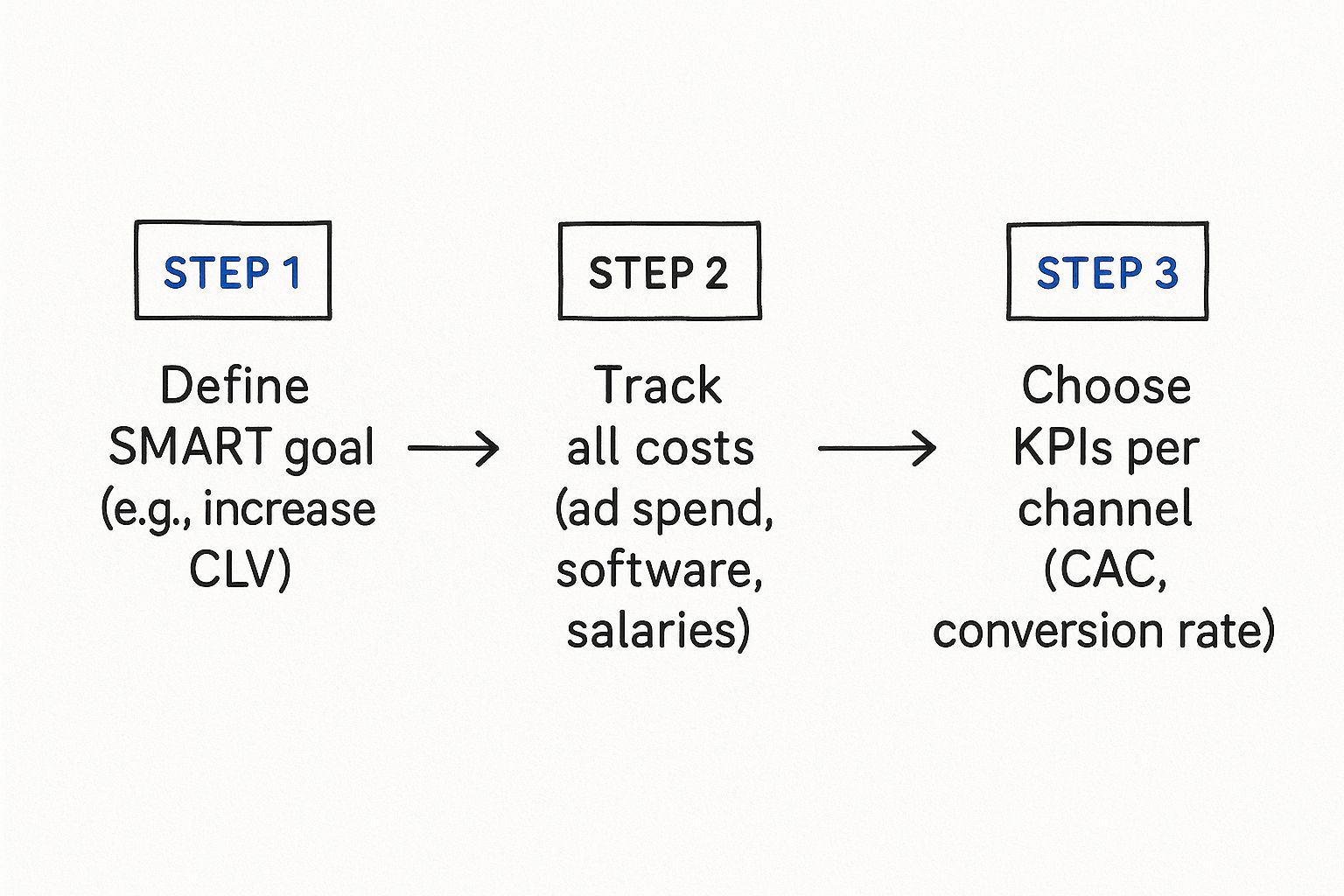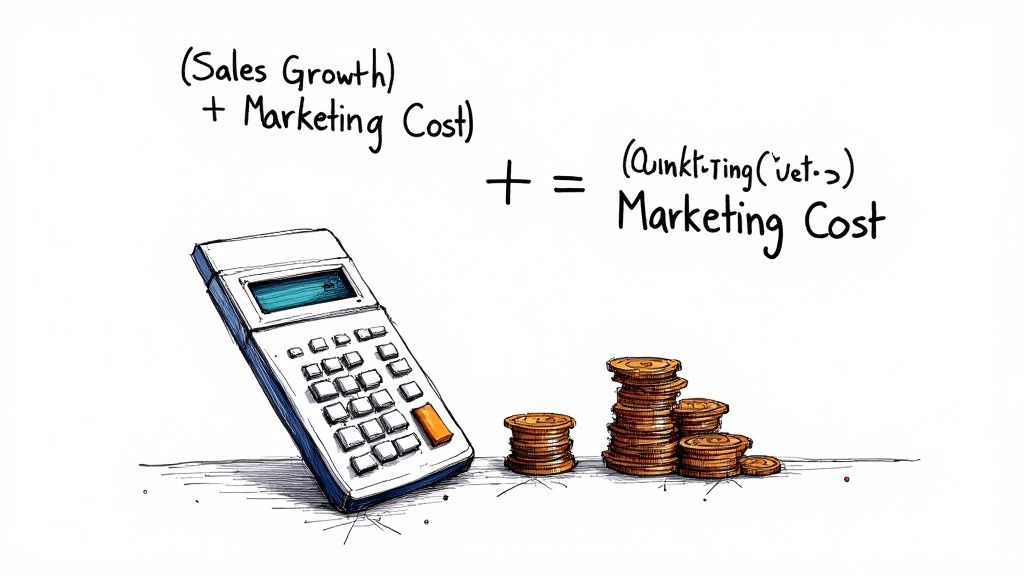How to Measure Marketing ROI Like a Pro
October 12, 2025

Measuring your marketing ROI really boils down to a simple, powerful formula: (Sales Growth - Marketing Cost) / Marketing Cost. This little equation is the key to figuring out how much revenue you’re actually generating for every single dollar you spend. It’s what turns your marketing activities into a tangible, provable business result.
Why Measuring Marketing ROI Is Your Secret Weapon

Let's get past the textbook definition for a second. Honestly, learning how to properly measure marketing ROI is the one skill that transforms marketing from a "cost center" into a genuine revenue driver. Without it, you’re just throwing money at different channels and hoping something sticks. But once you have a handle on it, you can make sharp, data-backed decisions that directly fatten the bottom line.
This isn't just a "nice-to-have" anymore; it's a must. Proving ROI has become a top priority for 83% of marketing leaders, which is a huge leap from where things were just five years ago. What’s more, 64% of companies now decide on future marketing budgets based on the ROI of past campaigns. This shift shows just how central this metric is to smart business planning. You can dig deeper into these marketing ROI statistics to see just how much the industry is leaning on this data.
Before we dive into the "how-to," let's quickly break down the essential pieces of the ROI puzzle. Getting these components right is the foundation for an accurate calculation.
Core Components of the ROI Calculation
| Component | Description | Example |
|---|---|---|
| Sales Growth | The increase in revenue directly attributable to a specific marketing campaign or effort. | A PPC campaign generated $25,000 in new sales over a 3-month period. |
| Marketing Cost | The total investment made in the marketing campaign. This includes ad spend, creative costs, software, and labor. | The total cost for the PPC campaign was $5,000 (including ad spend and management fees). |
| Return on Investment (ROI) | The final percentage or ratio that shows the profitability of the marketing investment. | ($25,000 - $5,000) / $5,000 = 4, or a 400% ROI. |
Understanding these elements is the first step. Now, let’s look at why mastering this calculation is so valuable.
The Strategic Value of ROI
Knowing your marketing return on investment gives you more than just numbers for a slide deck. It delivers real-world advantages that boost your influence and effectiveness.
You'll Secure Bigger Budgets: The conversation around budget completely changes when you can walk in and prove that every dollar you get generates five dollars back. You're not asking for a handout; you're presenting a clear-cut investment opportunity for the business.
You Can Optimize Your Strategy on the Fly: ROI data is your roadmap. It tells you exactly what’s working and what’s a waste of money. This allows you to confidently double down on channels that are crushing it and pull back from the ones that aren't, making every dollar work harder.
You'll Build Unshakeable Credibility: When marketers can speak fluently about revenue and profit, they earn a seat at the leadership table. Proving your direct contribution to growth solidifies your value and moves you beyond just being the "creative team."
Mastering ROI isn't just about justifying your marketing spend—it's about becoming an indispensable strategic partner in your company's growth. It transforms your conversations from "we got this many clicks" to "we generated this much revenue."
At the end of the day, measuring ROI gives you the clarity you need to navigate the often-murky waters of marketing. It’s the compass that keeps all your efforts pointed toward what truly matters: sustainable, profitable growth.
Setting the Stage for Accurate ROI Tracking
Before you even think about plugging numbers into a formula, you need to lay the groundwork. Honestly, this is where most marketers go wrong. The setup phase is what separates a truly insightful ROI figure from a misleading one. Get this right, and you'll have actionable data that can actually steer your strategy.
It all starts with defining what success really looks like for your business. Vague goals like "increase brand awareness" are impossible to measure in a way that means anything to the bottom line. You need to get specific with SMART marketing goals—that’s Specific, Measurable, Achievable, Relevant, and Time-bound—that tie directly back to tangible business outcomes.
Aligning Goals with Business Objectives
Your marketing goals can't live on an island. They have to directly support the company's bigger financial picture. Start thinking less about vanity metrics and more about the numbers that your CFO or CEO actually cares about.
Here are a few examples of strong, business-aligned marketing goals I've seen work well:
- Increase Customer Lifetime Value (CLV) by 15% within the next fiscal year through our new email retention campaigns.
- Slash our Customer Acquisition Cost (CAC) by 20% over the next six months by reallocating budget from underperforming ad channels to our top performers.
- Generate 500 new Marketing Qualified Leads (MQLs) for the sales team in Q3, driven specifically by our organic content strategy.
When you set these kinds of targets, you have a clear benchmark. You're no longer just running campaigns for the sake of it; you're executing a precise plan designed to hit a specific financial or operational goal.
The most accurate ROI calculations start with the clearest goals. When you know exactly what you're trying to achieve, every dollar spent and every metric tracked has a purpose. This clarity prevents you from getting lost in a sea of irrelevant data.
This infographic breaks down these foundational steps really nicely.

As you can see, it all flows from a clear goal. That leads to tracking your costs and picking the right KPIs, which are the essential ingredients for an accurate ROI measurement.
Tracking Every Single Dollar Spent
This might be the most common mistake I see: underestimating the total investment. To get a true ROI, you have to be ruthless about accounting for every single expense tied to a campaign, not just the obvious stuff. A complete cost breakdown has to include both your direct and indirect expenses.
Direct Costs:
- Ad Spend: The cash you're handing over to platforms like Google Ads, LinkedIn, or Meta.
- Agency or Freelancer Fees: What you pay your external partners for their creative, management, or strategic brainpower.
- Software Licenses: The monthly or annual fees for your marketing automation tools, analytics platforms, or your CRM.
Indirect Costs:
- Team Salaries: This is a big one. You need to allocate a portion of your marketing team's salaries based on the time they spent on that specific campaign.
- Content Creation Costs: The internal resources that went into designing graphics, writing copy, or shooting and editing videos.
- Overhead: A small slice of general business expenses (like rent or utilities) that supports the marketing department.
Forgetting to factor in these indirect costs will artificially inflate your ROI and give you a false sense of security. Meticulous cost tracking is the only way to ensure your calculations reflect the real investment you've made.
Choosing the Right KPIs for Each Channel
Finally, you have to pick the right Key Performance Indicators (KPIs) to actually measure progress toward your goals. The KPIs you watch will—and should—be different depending on the marketing channel and the specific goal. For example, the metrics for a PR campaign are worlds away from those for a paid search campaign. If you want to go deeper on that, there are some great specialized guides on public relations measurement that explain channel-specific KPIs.
Here’s a practical way to think about it:
- For a Google Ads campaign focused on driving sales: Your non-negotiable KPIs are Cost Per Acquisition (CPA), Conversion Rate, and Return on Ad Spend (ROAS).
- For an SEO strategy focused on lead generation: You’d be glued to your Organic Traffic Growth, Keyword Rankings for high-intent terms, and, most importantly, Organic Lead Conversions.
- For a social media campaign aimed at community building: You’d monitor metrics like Engagement Rate, Share of Voice, and Audience Growth Rate.
By carefully defining your goals, tracking all your costs, and selecting the right KPIs for each channel, you build a reliable system for measurement. This prep work is non-negotiable if you're serious about proving marketing's value.
The Marketing ROI Formulas That Actually Matter

Alright, this is where the rubber meets the road. While the idea of ROI can feel a bit fuzzy, the actual math is refreshingly straightforward. These formulas are your best tool for cutting through the vanity metrics and getting a clear financial verdict on your marketing.
Let's start with the classic, the one every marketer should have in their back pocket. It's the foundation for understanding ROI in its purest form.
The Classic Marketing ROI Formula
The most direct way to get a snapshot of your return is with this simple equation:
(Sales Growth - Marketing Cost) / Marketing Cost = Marketing ROI
Let’s run through a real-world scenario. Say your e-commerce shop launched a Google Ads campaign for a new line of products.
- Marketing Cost: You spent $10,000 all in. That’s $8,000 on ad spend and another $2,000 for the freelancer who managed the whole thing.
- Sales Growth: Over the course of the campaign, you can directly attribute $50,000 in new revenue to those ads.
When you plug these numbers into the formula, it looks like this:
($50,000 - $10,000) / $10,000 = 4
To get the percentage, just multiply that by 100. Your ROI is a very healthy 400%. This means for every single dollar you invested, you got $4 back after covering your costs. It's a powerful, universally understood metric that speaks volumes.
Moving Beyond the Basics with Advanced Formulas
While the classic formula is a must-know, it doesn't always paint the full picture. It’s great for quick-turnaround campaigns, but if you're in a business with a long sales cycle or you rely on recurring revenue, it can fall short. Leaning on immediate sales alone might lead you to undervalue marketing strategies that are quietly building profitable, long-term customer relationships.
This is where a couple of more advanced calculations come into play. They give you a much deeper, more sustainable view of your marketing's true financial impact.
True marketing insight comes from looking beyond a single transaction. A customer acquired today might generate revenue for years to come, and your ROI calculation needs to reflect that long-term value to be truly accurate.
Incorporating Customer Lifetime Value (CLV)
One of the most insightful ways to measure marketing ROI is by bringing Customer Lifetime Value (CLV) into the equation. CLV is an estimate of the total revenue you can expect from a single customer over the entire time they do business with you.
Here's how you can adapt the formula to account for it:
(CLV - Marketing Cost) / Marketing Cost = Marketing ROI
Let's apply this to a long-term play, like an organic SEO initiative.
- Marketing Cost: You invested $25,000 over six months in top-notch content and technical SEO work.
- New Customers: That effort brought 20 brand-new customers through your digital door.
- Average CLV: Looking at your historical data, you know the average customer has a lifetime value of $5,000.
First, you figure out the total value generated: 20 customers x $5,000 CLV = $100,000.
Now, run the formula:
($100,000 - $25,000) / $25,000 = 3
That’s a 300% ROI. Had you only measured the initial sales from those customers, the ROI might have looked disappointing. By using CLV, you prove the massive, long-term value your SEO investment is building.
The Critical CLV to CAC Ratio
Another incredibly useful metric is the ratio of your CLV to your Customer Acquisition Cost (CAC). This simple comparison tells you how much value you're generating versus how much you're spending to get each customer.
- CLV: The total value a customer brings over their lifetime.
- CAC: The total cost of sales and marketing to acquire one new customer.
A healthy business needs CLV to be substantially higher than CAC. The industry benchmark to shoot for is a ratio of 3:1 or better. For every dollar you spend to get a customer, you should be getting at least three dollars back in lifetime value.
For instance, if your CAC is $500 and your CLV is $2,000, your 4:1 ratio is fantastic. But if your CAC is $1,500 and your CLV is $2,000, that 1.3:1 ratio is a red flag. It signals that your acquisition strategy isn't sustainable and is barely profitable. This ratio is also a great proxy for your brand's strength, something you can dig into further when you how to calculate share of voice.
Using these more nuanced formulas helps you graduate from simply measuring campaign results to truly understanding the financial health of your entire marketing engine.
Untangling Attribution and Picking Your Tools
Measuring marketing ROI gets messy when a customer interacts with your brand multiple times before they actually buy something. Was it the first blog post they read a month ago that did the trick? Or was it the retargeting ad they finally clicked yesterday? This is the core problem that marketing attribution tries to solve.
Attribution is really just the process of giving credit where credit is due—assigning value to the various touchpoints along a customer's journey. If you get this wrong, you could end up pouring money into channels that look good on paper but aren't actually driving results, while accidentally cutting the ones that are quietly filling your pipeline.
The truth is, a lot of companies are flying blind. Over half of all marketers (51%) are using mobile advertising, but a tiny 17% can actually connect that spend to real financial outcomes. It’s a similar story for social media, where only 14% can confidently tie their efforts to revenue. This data, highlighted in an eye-opening financial attribution gap study on iab.com, shows just how widespread the attribution problem is.
How to Think About Attribution Models
Choosing an attribution model is like picking the right pair of glasses. Each one gives you a different perspective on your customer’s journey, and your choice will directly shape your ROI calculations and, ultimately, your strategy. There’s no single "best" model here; it all comes down to your business, your sales cycle, and what you’re trying to achieve.
Let’s walk through the most common models and when you might use them.
First-Touch Attribution: This one is simple: 100% of the credit goes to the very first interaction a person had with your brand. It’s all about what brought them through your front door.
- Best for: Businesses that are laser-focused on top-of-funnel awareness. If your main goal is figuring out which channels are best at introducing you to new people, this model is your friend.
- Example: Someone finds your brand for the first time by reading one of your SEO-optimized blog posts. Weeks later, they see a Facebook ad and click an email link before finally converting. With first-touch, that blog post gets all the glory.
Last-Touch Attribution: As you might guess, this is the polar opposite. It gives 100% of the credit to the final touchpoint right before the conversion. It’s focused on what sealed the deal.
- Best for: Companies with quick sales cycles, like most e-commerce brands. It answers the critical question, "What was the final nudge that pushed them over the edge?"
- Example: A customer clicks a promotional email and immediately makes a purchase. Even if they saw five of your ads in the weeks prior, the email gets all the credit.
While these single-touch models are easy to understand, they often paint a deceptively simple picture of a complex journey. That's where multi-touch models come into play.
Getting More Granular with Multi-Touch Models
Multi-touch attribution operates on the premise that multiple interactions contributed to the final sale, so it splits the credit among them. This almost always gives you a more balanced and realistic view of what’s actually working.
Linear Attribution: This is the most democratic model. It splits the credit equally across every single touchpoint in the customer's journey. No single interaction is treated as more important than another.
- Best for: Marketers who believe every interaction has value and want a complete picture of the customer path. This is especially useful in long B2B sales cycles.
- Example: A prospect reads a blog post, joins a webinar, clicks a LinkedIn ad, and then converts from a sales email. Each of these four touchpoints gets exactly 25% of the credit.
Time-Decay Attribution: This model is a bit more sophisticated. It gives more credit to the touchpoints that happened closer to the conversion. The first interaction still gets some credit, but the last one gets the most.
- Best for: B2B companies with long consideration phases, where the interactions right before a decision is made are often the most influential.
- Example: In that same four-touch journey, the final sales email might get 40% credit, the LinkedIn ad 30%, the webinar 20%, and the initial blog post only 10%.
Choosing the right attribution model isn't about finding a perfect formula. It's about aligning your measurement with what you care about most. Are you focused on discovery, the final push, or the entire journey? Your answer will point you to the right model.
The Tech That Makes It All Happen
All this theory is great, but you need the right tools to actually put these models into practice. Your marketing stack is where the data gets collected and the dots get connected, giving you a clear picture of what’s driving revenue.
Here are the essentials you'll want to have in place:
Web Analytics Platforms: Your journey starts with a tool like Google Analytics 4 (GA4). Its "Attribution modeling" report is a fantastic playground for comparing different models (like last-click vs. data-driven) to see how credit shifts between your channels. It's your window into what's happening on your website.
Customer Relationship Management (CRM) Systems: Your CRM—whether it’s HubSpot, Salesforce, or something else—is your source of truth for sales data. Integrating it with your marketing platforms isn't just a nice-to-have; it's essential for ROI measurement. This is how you connect marketing touchpoints to actual closed deals.
Specialized Attribution Software: For businesses with really complex customer journeys, you might want to look into dedicated platforms like HockeyStack or Ruler Analytics. These tools are built to stitch together data from all over the place to give you one unified view of the customer journey, from the first ad they saw to the final purchase. The massive datasets involved often require a deeper level of analysis, and you can learn more about how data science in marketing is used to pull out these kinds of powerful insights.
Turning Your ROI Data Into Smarter Decisions

So, you've done the hard work and calculated your marketing return on investment. That’s great, but it’s only half the job. The real value comes from what you do next.
Think of your ROI numbers less like a final grade on a report card and more like a compass pointing you toward your next move. The data is meaningless until it sparks action and helps you make smarter, more profitable decisions for the business. This is where you graduate from being a data collector to a true marketing strategist.
Spotting Your Winners and Losers
The first thing to do is a simple but powerful sorting exercise. Lay out all your campaigns and channels and group them based on their ROI. You're trying to quickly identify the high-flyers that deserve more fuel and the budget black holes that are dragging you down.
Let's say your analysis shakes out like this:
- High-ROI Winner: That targeted LinkedIn ad campaign you ran for the finance vertical? It's bringing in a 7:1 ROI. A clear winner.
- Moderate Performer: Your long-term organic SEO efforts are chugging along nicely, showing a steady 4:1 ROI when you factor in Customer Lifetime Value (CLV).
- Low-ROI Loser: A broad display ad campaign is barely washing its own face with a 1.5:1 ROI, yet it's eating up a significant chunk of your budget.
This simple breakdown gives you an immediate, data-backed roadmap. You now have a solid case for pulling funds from those weak display ads and doubling down on your high-performing LinkedIn strategy.
Turning data into decisions is the most critical step in measuring marketing ROI. Don't just report the numbers—use them to justify budget shifts, optimize creative, and kill campaigns that aren't pulling their weight. This is how you drive real growth.
Using A/B Testing to Supercharge Performance
Beyond just shuffling budgets between channels, your ROI data is a goldmine for fine-tuning your campaigns. When you pair A/B testing with ROI analysis, you unlock a much deeper level of insight. Instead of just seeing which landing page got more clicks, you can see which one actually made more money.
Imagine you're testing two ad creatives on Facebook:
- Creative A gets a fantastic click-through rate (CTR), but ultimately delivers an ROI of 250%.
- Creative B has a lower CTR, but it attracts a much better-qualified audience, leading to an incredible 400% ROI.
If you were only looking at vanity metrics like CTR, you might have mistakenly crowned Creative A the winner. But with a clear view of the return, you know Creative B is the real moneymaker. This kind of insight lets you continuously refine your messaging and targeting for maximum profitability.
Creating a Continuous Feedback Loop
At the end of the day, measuring marketing ROI isn't a one-and-done task you check off a list. It’s a living, breathing process. It's a continuous feedback loop that should inform your strategy every single month and every single quarter.
Each campaign gives you a new set of data points, and those data points make your next decision a little bit smarter. This disciplined, iterative approach is what truly separates the best marketing teams from the pack. In fact, companies that lean into data-driven marketing report a 5-8% higher ROI than their competitors.
With over half of marketers (54%) now actively measuring content marketing ROI, it's obvious that this level of tracking is becoming the industry standard. You can learn more about the measurable advantages of advanced data utilization and see how this plays out across different sectors.
By consistently analyzing your returns, you build a culture of accountability and continuous improvement. You stop just "running campaigns" and start building a smarter, more efficient marketing engine that gets better with every dollar you spend.
Answering Your Toughest Marketing ROI Questions
Even when you have the formulas and tools lined up, the real world has a way of throwing curveballs. When you start digging into how to measure marketing ROI, you run into those tricky, practical questions that most guides just gloss over.
Let's get into the weeds and tackle those head-on with some straight-up, practical answers.
What Is a Good Marketing ROI?
This is the million-dollar question, isn't it? The honest-to-goodness answer is, "it depends." I know that's not what you want to hear, but it's the truth.
If you're looking for a general rule of thumb, a 5:1 ratio is often thrown around as a solid benchmark. That means for every $1 you put into marketing, you get $5 back in revenue. Anything hitting a 10:1 ratio or better is usually considered knocking it out of the park.
But context is everything. A 3:1 return could be a massive win for a SaaS company with high-profit margins. For a low-margin e-commerce business getting squeezed by shipping costs, that same 3:1 might be a sign of trouble.
Here's a better way to think about it: Stop chasing universal benchmarks and start setting your own. The real goal isn't to hit some arbitrary industry number. It's to consistently beat your own historical performance, quarter after quarter.
How Do I Measure ROI for Long-Term Plays like SEO?
Calculating the return on strategies like SEO or content marketing is a different ballgame. You can't measure a six-month SEO push with the same 30-day snapshot you’d use for a PPC ad. That’s like planting an oak tree and getting frustrated you don't have a tire swing by Tuesday.
For these long-game channels, you need to shift your focus to leading indicators and track value over a much longer horizon, typically 6-12 months.
- Look for Leading Indicators: Keep an eye on the steady growth of things like organic traffic, keyword ranking improvements (especially for high-intent terms), and the number of leads coming from organic search. These are the breadcrumbs that show your strategy is working and gaining momentum.
- Tie It Back to Customer Lifetime Value (CLV): This is where the magic happens. A blog post might not get you a sale today. But if it attracts a customer who sticks around for three years, its ultimate ROI is huge. You have to use your analytics to trace that customer's journey all the way back to their first organic touchpoint.
Patience is the name of the game here. Long-term channels build assets for your business, and their ROI often compounds in ways short-term campaigns simply can't.
What Common Mistakes Should I Avoid?
The biggest pitfalls in measuring marketing ROI are surprisingly common, but just knowing what they are gives you a massive advantage. If you can steer clear of these traps, your data will be cleaner and your insights far more valuable.
From my experience, these are the top mistakes I see marketers make time and again:
- Forgetting 'Soft' Costs: It’s so easy to just track the obvious stuff, like your ad spend. But what about the portion of your team's salaries dedicated to the campaign? Or the monthly cost of your marketing automation software? Or the creative agency fees? Forgetting these will seriously inflate your ROI and paint a dangerously inaccurate picture.
- Using the Wrong Attribution Model: Applying a simple last-touch model to a complex B2B sales cycle is a classic blunder. It gives 100% of the credit to the final click, completely ignoring all the blog posts, webinars, and social media interactions that nurtured that lead for months.
- Ignoring Long-Term Value: Focusing only on immediate sales is incredibly shortsighted. This tunnel vision overlooks crucial metrics that build a healthy business, like brand lift, improvements in customer retention, and gaining share of voice. All of these contribute to profitability down the road.
- Inconsistent Tracking: If you measure things one way this quarter and another way next quarter, you can't compare apples to apples. Your trend lines become meaningless. You have to establish a consistent, disciplined process for how you collect your data—it’s non-negotiable for any meaningful analysis.
By sidestepping these common errors, you can be confident that the ROI you're reporting isn't just a number on a dashboard, but a true reflection of marketing's financial impact on the business.
Ready to get your story in front of the right journalists and see a real return on your PR efforts? PressBeat uses advanced AI to connect your brand with influential publications, ensuring your message gets heard. Start your high-impact press outreach today at pressbeat.io.